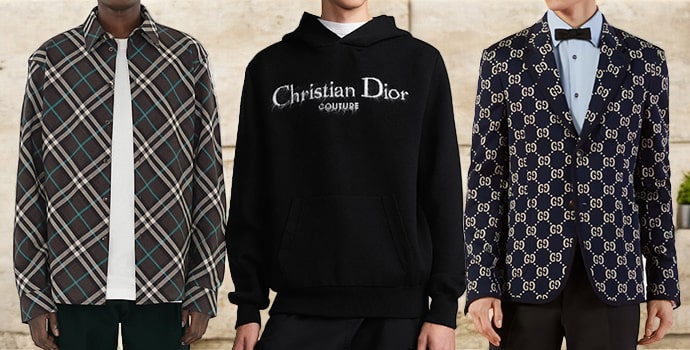Branded Clothing and the Rise of Recycled Fabric Use in Fashion
Branded Clothing and the Rise of Recycled Fabric Use in Fashion
Blog Article
The Importance of Lasting Clothing: Exactly How It Affects the Atmosphere and Your Wardrobe
Lasting garments is significantly identified for its vital duty in decreasing the ecological influence of the fast apparel industry. By concentrating on green products and moral manufacturing methods, it deals with pressing environmental problems. This change not only benefits the world yet additionally affects customer selections, resulting in an extra thoughtful method to wardrobe management. Recognizing these characteristics increases crucial concerns regarding style's future and individual obligation in shaping it.
The Ecological Impact of Fast Fashion

Advantages of Sustainable Products
Sustainable products offer significant advantages, particularly with eco-friendly textile selections that minimize environmental harm. These products also demonstrate resilience and longevity, decreasing the requirement for frequent substitutes. Therefore, they add to a much more sustainable garment industry and advertise liable customer actions.
Eco-Friendly Textile Choices
While the garment industry has actually long been related to quick patterns and environmental damage, the rise of eco-friendly material options provides a transformative chance. Lasting materials such as organic cotton, hemp, and Tencel have actually gotten appeal due to their lower eco-friendly impact. These materials are frequently created without dangerous chemicals and need much less water, minimizing their carbon impact - Branded Clothing. Furthermore, many environmentally friendly textiles are eco-friendly, contributing to a circular economic situation by reducing waste. Selecting sustainable products not only supports ecologically responsible methods but likewise advertises much healthier environments. As consumers become a lot more aware of their acquiring power, the need for environmentally friendly fabrics urges brand names to innovate and embrace even more lasting production methods, eventually benefiting the earth and future generations
Longevity and Durability Advantages
Numerous customers are significantly recognizing the longevity and longevity benefits of lasting products in their clothing options. Unlike standard textiles, sustainable materials such as organic cotton, hemp, and recycled polyester are crafted to endure deterioration, leading to garments that last much longer. This minimized frequency of substitute not only saves consumers money over time but also lessens waste created by fast fashion. Additionally, sustainable clothes commonly employs green production techniques that boost textile strength, adding to a reduction in the general carbon impact. By purchasing sturdy clothes, consumers can grow a much more lasting closet while appreciating premium pieces that preserve their visual and capability with time. Subsequently, sturdiness and longevity stand as key benefits of selecting sustainable materials.
Minimizing Waste Through Lasting Practices
Minimizing waste in the garment industry can be accomplished with innovative practices such as upcycling and repurposing products. In addition, adopting minimalist wardrobe approaches motivates consumers to focus on high quality over amount, eventually decreasing clothing intake. Together, these techniques contribute greatly to a more lasting apparel model.
Upcycling and Repurposing Materials
Upcycling and repurposing materials have actually arised as innovative approaches in the garment industry, transforming disposed of textiles into valuable brand-new items. This approach not just reduces waste yet likewise motivates creative thinking and uniqueness in clothing style. By taking old garments and materials, developers can produce distinct items that reflect personal style while minimizing the demand for brand-new sources. Furthermore, upcycling commonly requires less energy and water compared to conventional manufacturing procedures, significantly decreasing the ecological impact of fashion. As consumers come to be extra familiar with sustainability, the popularity of upcycled apparel proceeds to rise, advertising a round economic climate. Inevitably, these techniques add to a more sustainable future, where fashion prioritizes ecological health over quick manufacturing and usage.

Minimal Closet Techniques
As individuals progressively look for to lessen their environmental impact, taking on minimalist closet techniques has obtained grip as a reliable technique to lasting style. These approaches stress top quality over amount, encouraging consumers to curate a smaller collection of versatile, resilient clothes. By focusing her comment is here on classic items that can be blended and matched, individuals can reduce the regularity of acquisitions and eventually reduce waste.Additionally, minimalism promotes mindful intake, prompting customers to show on the environmental and ethical ramifications of their choices. This approach not just promotes a more sustainable lifestyle however also streamlines daily decision-making regarding outfit. As individuals embrace minimalist principles, they contribute to a fashion society that values sustainability and liable consumerism, inevitably leading to an extra eco-conscious culture.
The Role of Moral Labor in Sustainable Style
While lots of consumers are significantly familiar with the environmental repercussions of their apparel choices, the value of ethical labor techniques in sustainable style can not be overlooked. Honest labor encompasses fair salaries, secure working problems, and respect for employees' legal rights, forming the backbone of accountable style production. Brand names that prioritize honest labor not only boost communities however additionally set a requirement for accountability in the industry.Moreover, the assimilation of ethical methods cultivates transparency, making it possible for customers to make informed options about their purchases. This method contrasts dramatically with rapid style's unscrupulous labor models, which commonly prioritize earnings over people. By sustaining business dedicated to ethical labor, consumers contribute to a system that values human self-respect along with environmental sustainability. Ethical labor is not merely an add-on; it is vital to the broader goal of lasting fashion, guaranteeing that the pursuit for eco-friendliness does not come at the expenditure of human legal rights.
The Impact of Sustainable Garments on Carbon Emissions
Lasting clothing has the possible to significantly reduce carbon emissions related to the fashion business. Typical garment production contributes significantly to greenhouse gas exhausts, mainly due to energy-intensive manufacturing procedures and using non-renewable resources. In contrast, lasting fashion concentrates on environmentally friendly materials, such as natural cotton or recycled fibers, which usually call for much less power to produce.Moreover, sustainable brand names have a tendency to embrace more effective production methods, minimizing waste and decreasing overall exhausts. By prioritizing toughness and timeless design, lasting clothes motivates customers to acquire less regularly, additional lowering the carbon footprint connected with overconsumption.Additionally, lots of sustainable brands are dedicated to transparency in their supply chains, enabling customers to make informed choices that line up with their values. Inevitably, shifting towards sustainable apparel can cause a significant decrease in carbon emissions, contributing to a healthier earth and an extra sustainable future for the apparel industry.
Sustaining Local Economic Situations With Sustainable Choices
The shift towards lasting clothing not only addresses ecological worries yet likewise significantly advantages regional economies. By picking sustainable style, customers commonly sustain regional craftsmens and small companies, enhancing community resilience. These business commonly run on a smaller sized scale, focusing on workmanship and moral practices over mass production.Investing in locally made sustainable garments promotes work development and promotes economic growth within neighborhoods. As consumers become more familiar with the environmental impact of their acquisitions, they increasingly look for products that reflect their worths. This need urges neighborhood suppliers to take on lasting techniques, contributing to a round economy.Moreover, sustaining neighborhood businesses reduces transportation emissions, straightening with eco-conscious customer behavior. The interconnectedness of lasting clothing and local economic climates highlights the crucial duty that specific selections play in advertising both ecological and economic health and wellness. By promoting these local links, communities can prosper while also functioning towards a much more lasting future.
Changing Your Closet: Tips for a Lasting Wardrobe
As individuals my latest blog post look for to minimize their ecological impact, changing a storage room into a lasting wardrobe comes to be an essential action. One effective technique is to evaluate existing garments, keeping just things that are used routinely and that line up with sustainability objectives. Focusing on quality over quantity is vital; purchasing durable pieces from green brand names can greatly lower waste.Additionally, integrating used items can revive a wardrobe while lessening ecological damages. Organizing apparel swaps with pals or giving away extra items can additionally advertise sustainability.When shopping, people should seek materials that are organic, recycled, or naturally degradable, and stay clear of fast fashion sellers - Branded Clothing. Ultimately, hop over to these guys exercising mindful consumption by thoughtfully taking into consideration each purchase can add to a more sustainable way of life. By applying these pointers, one can create a wardrobe that reflects individual style while sustaining ecological stewardship
Frequently Asked Questions
Just How Can I Identify Lasting Clothing Brands?
To identify sustainable garments brand names, one need to look into products used, look for certifications like Fair Trade, and take a look at the brand name's openness regarding their production processes, labor methods, and ecological impact, making certain ethical and green techniques are prioritized.
What Are the Costs Linked With Lasting Fashion?
The costs associated with sustainable style can differ substantially. Greater production costs, honest sourcing, and environmentally friendly materials often bring about boosted retail costs, which may hinder some customers while attracting environmentally mindful shoppers.
Can Sustainable Clothing Be Stylish and trendy?
Sustainable clothing can indeed be stylish and trendy. Designers increasingly prioritize ingenious products and honest production techniques, showing that style and sustainability can exist together. Consumers currently have diverse alternatives that blend looks with environmental consciousness.
Just How Does Laundering Clothing Affect Their Sustainability?
Cleaning clothing greatly influences sustainability by consuming water and energy, adding to contamination, and creating microplastic release. Constant washing can weaken fabrics, reducing their lifespan and raising the need for substitutes, ultimately aggravating environmental worries.
What Is the Lifespan of Lasting Clothing Contrasted to Rapid Fashion?
The life-span of lasting clothing normally goes beyond that of fast fashion items, typically long-term a number of years due to top quality materials and craftsmanship. In contrast, rapid fashion garments may degrade quickly, necessitating more regular replacements. Sustainable clothes is progressively recognized for its crucial function in reducing the ecological influence of the fast fashion market. While lots of customers are increasingly mindful of the environmental consequences of their clothes options, the relevance of moral labor techniques in lasting style can not be forgotten. Branded Clothing. Sustainable clothing has the prospective to substantially lower carbon emissions associated with the fashion sector. In comparison, lasting fashion focuses on environment-friendly materials, such as natural cotton or recycled fibers, which often call for much less power to produce.Moreover, sustainable brands tend to embrace extra reliable production practices, reducing waste and decreasing total exhausts. By focusing on sturdiness and classic style, sustainable clothing urges consumers to buy much less regularly, further decreasing the carbon footprint associated with overconsumption.Additionally, lots of lasting brand names are devoted to openness in their supply chains, allowing customers to make educated selections that line up with their worths
Report this page